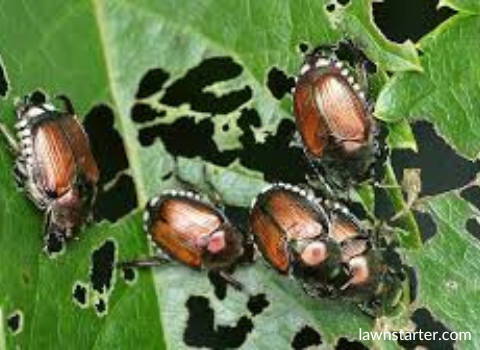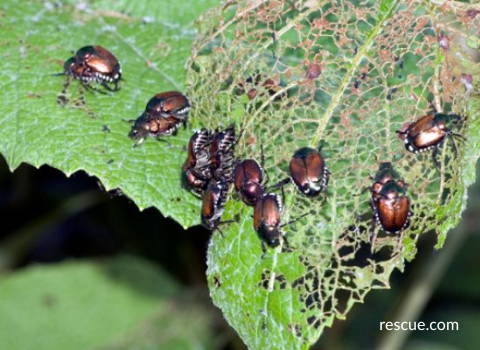Who Eats Japanese Beetles
Japanese Beetles, Popillia Japonica is known as a plant pest in North America and chomp through the leaves of various ornamental and garden plants, vegetables, and fruit trees. For more than a century ago, it was believed that it was imported from Asia to the United States by accident through plants.
Japanese beetles feed on different kinds of plants while the larvae or white grubs feed on the roots. Adults have metallic green and bronze wing coverings and are about 1cm in length. These pests always feed in groups, which can result in leaving plants with only branches.
Getting rid of these pests are known to be more difficult since these are living underground. At the early stages of their life cycle, these insects are like other grubs and stay underneath the soil. Also, they are active in the summer for a short time only. Therefore, it is difficult to get rid of these species once a property gets infested.
Predators of Japanese Beetles
Most pest insects are cyclic with their population densities. Once the living conditions are favourable, there will be an increase in the herbivore population.
As the population of these insects increases, the number of their natural predators also increases. However, it takes some time for these predators to catch up to the populations of the beetles and start reducing their densities. This catch-up period is known as the lag time.
When the predators start catching up with the increasing number of beetles, their number will also start reducing. In time, the number of these predators will also reduce since their main food source is starting to decrease. This is called cyclic populations, the sudden disappearance of pests in high densities and then suddenly increase again.
Tachinid Flies
Most predators are attacking the Japanese beetle grubs or the larval grub stage of these beetles than the adult Japanese beetles. Among the common natural predators of these beetles are tachinid flies.
These parasitoids do not only eat Japanese Beetles but also eat sawfly larvae, caterpillars, earwigs, grasshoppers, beetle larvae and adults, and some true bugs.
Birds
Among the predators that eat both grubs and the adults is the starling. Yes, it may be a pest bird, but this is something beneficial for some property owners, especially those that are dealing with Japanese beetles.
Aside from starling, ducks also eat these beetles. If you are in a rural area, you can use this as an alternative to pesticides. They eat both the adult and larvae, which will help you in getting rid of these pests in your garden.
However, the downside in having ducks in the garden is they may trample young plants and even eat them. They may also dig through your mulch as they search for slugs and bugs.
If you have extra space on your property, taking care of ducks is easy. You just must put them in a fenced enclosure. There are breeds that require the wings to be clipped so they will not fly away. You can also add a man-made pool or a chlorine-free pool since they like to swim each day.
Other bird species that can help in achieving Japanese beetle control are:
Crows
Robins
Blue Jays
Sparrows
Cardinals
Wild turkeys
Other predators also include:
Ground Beetles
Assassin Bugs
Shrews
Spiders
Ants
Skunks
Raccoons
Moles
Predatory Stink Bugs
Nematodes
Nematodes attack and kills larvae or grubs. However, they are not known to have any negative effects to garden plants. Most people unknowingly introduce nematodes to their gardens unless they do not like potatoes and squash or do not like to garden a certain area anymore.
Milky Spore
When sprinkled on the ground, this bacterial disease will infect and kill the larvae. It is known as pervasive and will continue reproducing to continuously kill larvae to as long as 10 years after the first application.
The negative side of this option is that it does not work with adult beetles. If you found beetles in large numbers in your area, this option may not work effectively in your area.
Gregarine
This is a parasite that is killing the beetle in its native surroundings found in Korea and Japan. This is a form of control that was studied in the US. However, it is found ineffective since the adults can fly away easily even in controlled areas.
Tips in Getting Rid of Japanese Beetles
Regardless of if you know the predators of these beetles, you may not have these predators around your property. If you end up having this problem, you should consider other methods in getting rid of these pests instead.
One way of getting rid of these pests is by handpicking them from infested plants and putting them in a container with soapy water. This will prevent them from flying around and eventually drown them.
These pests are commonly attracted to fragrant plants. Since they feed in groups, it might look easy for you to collect them at first. However, it takes patience and vigilance for you to achieve a big payoff in doing this method.
This means that you need to check on the plants every single day and handpick them day by day. Make sure that you always have the container of soapy water ready to immediately put the beetles you collected in it. In time, you will notice a decrease in their number and notice the improvement in how your affected plants look.
Pesticides Maybe Time-Consuming but It Works
Soapy water is considered by commercial nurseries and most gardeners as the most effective method to eradicate Japanese beetles. If you are considering the use of pesticides, you need to spare some time to mix and prepare the pesticide.
You should also include enough time in spraying it on the infested plants and cleaning up the killed pests right after. This is the reason why more people are turning to the use of soapy water instead of the use of pesticides.
Aside from pesticides, you can also use professional-grade beetle traps. This is highly recommended for those with acres of plants. For those with small gardens, beetles may tend to always gather in their favorite plants and then avoid the traps.
If you are interested in using traps, some products we can recommend are Rescue Japanese Beetle Trap, Safers Japanese Beetle Trap, POT-It Plant Multi Insect RESIDUAL 400gr, and Scotts Grub B Gon Grub Killer 1.40kg.



